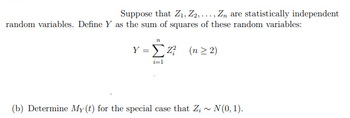
A First Course in Probability (10th Edition)
10th Edition
ISBN: 9780134753119
Author: Sheldon Ross
Publisher: PEARSON
expand_more
expand_more
format_list_bulleted
Question

Transcribed Image Text:Suppose that Z₁, Z2,..., Zn are statistically independent
random variables. Define Y as the sum of squares of these random variables:
12
Y = Z² (n ≥2)
i=1
(b) Determine My (t) for the special case that Zi~ N(0, 1).
Expert Solution
This question has been solved!
Explore an expertly crafted, step-by-step solution for a thorough understanding of key concepts.
Step by stepSolved in 2 steps with 2 images

Knowledge Booster
Similar questions
- The following 3x 3 contingency table contains observed 2. frequencies for a sample of 240. Column Variable Row Variable A 20 30 30 20 25 30 60 10 15 a. State null and alternative hypotheses to test for independence of the row and column variables. b. What are expected frequencies for each item?| c. What is the value of test statistic? d. Using a = 0.05 . What is the degree of freedom? What is the p-value? Using the p-value approach, what is your conclusion? |arrow_forward./arrow_forwardQ 6.1. Suppose Z = (Z₁, Z2, Z3) is a standard multi-variate Gaussian random variable i.e., for i ≤ 3, Zi~ N(0, 1) are i.i.d. random variables. Each of the random variables, (a)–(d), on the left is equal in distribution to exactly one random variables, (1)–(4), on the right. Pair up according to "equal in distribution" and explain briefly your reasoning. X₁ (a) X₂ (b) (x₂) - (2) (c) (x²) - (¹/1² 1/√²) (2₁) (3/√2 = √2 = (V2) Z₁ (d) (x) - (1) (²) X2 Y₁ (9)-(-) (2) (1=1) Y₂ (1) Y₁ (²) (4) - (1/² (3) (1/√√2 1/√2-1/√2) (x₁) = (²₁ ² ✓/³²) (3) 2 2 √2 1 Z3 Y₁ → ()-()) (4) = Y₂ 1/2) (2) 1) (2)arrow_forward
- The random variables ξ, ξ1, ξ2, . . . are independent and identically distributed with distribution P (ξ = 0) = 1/4 and P (ξ = j) = c/j for j = 1, 2, Let X0 = 0 and Xn = max(ξ1, . . . , ξn) for n = 1, 2, . . .. What value must c take? Explain why {Xn, n = 0, 1, 2,..... } is a Markov Write down the transition Draw the transition diagram and classify the states (aperiodic, transient, re- current, eorgodic, etc). Calculate P (Xn = 0). Calculate P (X4 = 3, X2 = 1|X1 = 3).arrow_forwardFor the random variables X,Y Cov(X,Y) = -0.9 if Z=3-X then what is Cov(Z,Y)=???arrow_forwardSuppose that the random variables Y1,..., Y(n > 2) satisfy Y - Ba, + Ei, i= 1,2,..., T, where 1,..., En are iid N(0, o), and both B and o are unknown. (a) Assume z1,..., In are fixed known constants. Here we observe Y1 = n,., Y observed data Y = y = (y1,..., Yn). Find a two-dimensional sufficient statistic of Y = (Yı,., Yn) for (8,0?). (b) Assume now that a1,...,n are random variables with a known joint distribution m(r1,..., In), and the r,'s are independent of G's (it is traditional in the linear regression to use lower case for independent variables r;'s). In this case, the observed data (Y, x) = {(Yi, r;)}i-1,n. Find a three- dimensional sufficient statistic of (Y, x) for (B,02). Im, and thearrow_forward
arrow_back_ios
arrow_forward_ios
Recommended textbooks for you
 A First Course in Probability (10th Edition)ProbabilityISBN:9780134753119Author:Sheldon RossPublisher:PEARSON
A First Course in Probability (10th Edition)ProbabilityISBN:9780134753119Author:Sheldon RossPublisher:PEARSON

A First Course in Probability (10th Edition)
Probability
ISBN:9780134753119
Author:Sheldon Ross
Publisher:PEARSON
